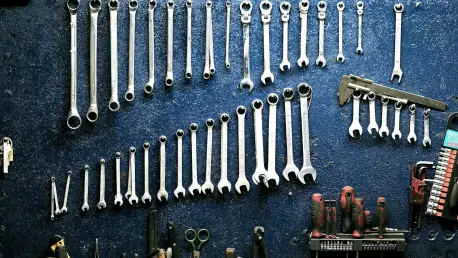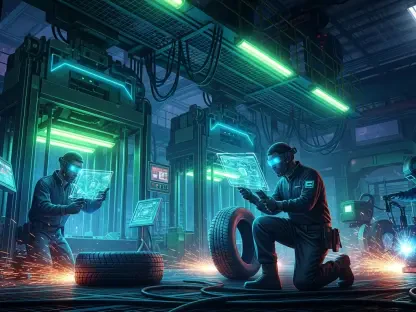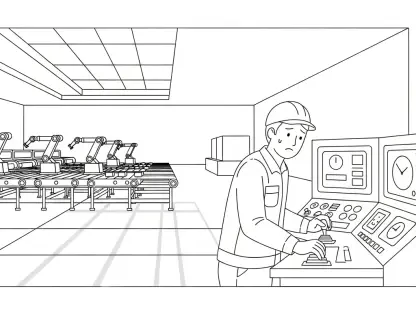Louisiana’s industrial heartland, a critical hub for chemical and manufacturing operations, is undergoing a profound transformation driven by the integration of artificial intelligence (AI) and machine learning (ML) into maintenance practices. Across the state, from BASF’s facilities in Geismar to ExxonMobil’s operations in Baton Rouge and Sasol’s plants in Lake Charles, companies are harnessing these advanced technologies to move beyond traditional repair methods. This shift is redefining how industrial giants manage equipment health, focusing on predicting failures before they occur and prescribing precise solutions to prevent costly disruptions. The impact is evident in reduced downtime, slashed maintenance expenses, and enhanced operational reliability. Far from a mere trend, this technological evolution signals a new era for the sector, where data-driven decisions and proactive strategies are becoming the norm. This exploration delves into the mechanisms behind this change, the benefits already realized, and the challenges that lie ahead in fully embracing AI’s potential.
Redefining Maintenance with Predictive Strategies
Louisiana’s industrial sector is witnessing a monumental shift as predictive maintenance, powered by AI and ML, replaces outdated reactive approaches with forward-thinking solutions. Major players like BASF are leveraging historical and real-time data to monitor equipment conditions continuously, identifying potential issues long before they escalate into major failures. This early detection capability significantly boosts asset availability, ensuring production units operate with minimal interruptions. The ripple effect is clear: unplanned downtime diminishes, sparing companies the high costs associated with emergency repairs. Moreover, this method reduces the unnecessary use of spare parts, aligning resource allocation with actual needs rather than guesswork. As a result, labor expenses also see a decline, since fewer urgent interventions are required. This proactive stance is setting a benchmark for efficiency, fundamentally altering how maintenance is perceived and executed in industrial environments across the state.
Beyond the immediate operational advantages, predictive maintenance is proving to be a strategic tool for long-term planning in Louisiana’s industrial landscape. Companies like ExxonMobil are applying these technologies across a wide range of assets, from compressors to control valves, to anticipate wear and tear with remarkable precision. This approach not only prevents unexpected breakdowns but also allows for scheduled maintenance during optimal windows, avoiding disruptions to production cycles. The data collected through AI systems provides insights into equipment lifespan, enabling better investment decisions for replacements or upgrades. Additionally, the reduction in sudden failures contributes to a safer working environment, as potential hazards are addressed before they pose risks. This shift from firefighting to forecasting represents a cultural change within the sector, where maintenance teams are empowered with actionable intelligence to keep operations running smoothly and sustainably.
Elevating Efficiency through Prescriptive Insights
Building on the foundation of predictive maintenance, prescriptive maintenance takes innovation a step further by not only foreseeing equipment issues but also offering tailored solutions to address them. Sasol’s implementation of an asset performance management platform stands as a prime example, utilizing AI-driven insights to pinpoint root causes of potential failures and recommend specific actions. This technology moves beyond mere alerts, directing maintenance efforts toward critical assets rather than adhering to rigid, less effective schedules. By factoring in variables such as machine age and recent performance, prescriptive tools ensure that interventions are both timely and precise. The continuous learning nature of ML algorithms enhances their accuracy over time, adapting to evolving conditions and improving decision-making processes. This targeted approach minimizes wasted effort, streamlines manpower allocation, and sets a new standard for operational excellence in Louisiana’s industrial facilities.
The adoption of prescriptive maintenance also fosters a deeper integration of data analytics into daily operations, reshaping how companies prioritize resources. At facilities like those operated by Sasol in Lake Charles, the ability to analyze complex datasets allows for a nuanced understanding of equipment health, guiding technicians to focus on high-priority repairs. This method contrasts sharply with traditional practices, where maintenance might be performed unnecessarily on equipment that poses no immediate risk. The cost savings are substantial, as resources are conserved for where they are truly needed, while production uptime is maximized through strategic interventions. Furthermore, prescriptive insights help in identifying systemic issues that might not be apparent through predictive data alone, offering a pathway to address underlying problems before they recur. This sophisticated layer of maintenance technology is proving indispensable for companies aiming to maintain a competitive edge in a demanding industrial market.
Amplifying Impact with Cutting-Edge Tools
The power of AI in maintenance is significantly enhanced by the integration of complementary technologies such as the Industrial Internet of Things (IIoT), digital twins, and wireless sensors, which are becoming commonplace in Louisiana’s industrial sector. Sasol, for instance, employs IIoT sensors to transmit real-time data into digital twins—virtual replicas of physical assets embedded with failure models. This setup enables the early detection of anomalies, allowing teams to act before issues escalate into costly breakdowns. These tools create a seamless flow of information, bridging the gap between physical equipment and digital analysis, and providing a comprehensive view of operational health. The precision offered by such systems reduces guesswork, ensuring that maintenance is both proactive and efficient. As these technologies become more widespread, they are paving the way for a more connected and responsive industrial ecosystem across the state.
In parallel, the exploration of autonomous robotics and other advanced tools signals an exciting frontier for maintenance practices, with BASF leading the charge in testing such innovations. Robotics can perform predictive tasks and suggest immediate corrective actions, minimizing human intervention in hazardous or hard-to-reach areas. This not only enhances safety but also speeds up response times, as automated systems can operate continuously without the constraints of human schedules. The data gathered by these robots feeds back into AI models, further refining their predictive and prescriptive capabilities. Additionally, technologies like augmented reality are beginning to support technicians by overlaying critical information during repairs, blending digital insights with physical tasks. This convergence of disruptive technologies points to a future where automation and digitalization dominate maintenance, promising even greater reliability and cost efficiency for Louisiana’s industrial giants as they continue to evolve.
Navigating Barriers to Full Adoption
Despite the transformative benefits of AI-driven maintenance, significant challenges remain in achieving widespread implementation across Louisiana’s industrial sector. One prominent obstacle, as highlighted by BASF, is the rapid pace of technological advancement, which complicates the evaluation and selection of the most suitable solutions. With innovations emerging constantly, companies must navigate a crowded landscape of tools and platforms, risking investment in systems that may soon become obsolete. Additionally, the physical installation of sensors and other monitoring equipment often requires alignment with planned outages, creating logistical hurdles that can delay deployment. These barriers underscore the need for strategic planning and robust vendor partnerships to ensure that chosen technologies align with long-term operational goals, while also maintaining flexibility to adapt to future developments in the field.
Another critical challenge lies in data quality and the integration of legacy systems, an issue frequently noted by both ExxonMobil and Sasol in their operations. Many industrial facilities rely on older equipment that lacks the connectivity required for modern AI tools, limiting the scope of predictive capabilities. Inadequate data coverage can lead to incomplete analyses, reducing the reliability of forecasts and prescriptions. Addressing this requires substantial investment in digital infrastructure to retrofit assets with necessary sensors and ensure seamless data flow. Moreover, ensuring the accuracy and consistency of data collected remains a persistent concern, as flawed inputs can undermine even the most sophisticated algorithms. Despite these obstacles, the industry remains optimistic, recognizing that overcoming such hurdles through enhanced data management and targeted upgrades will unlock the full potential of AI in transforming maintenance practices.
Charting the Path Forward with Digital Innovation
Reflecting on the journey so far, the integration of AI and ML into Louisiana’s industrial maintenance landscape marked a turning point for companies like BASF, ExxonMobil, and Sasol. Their adoption of predictive and prescriptive strategies fundamentally altered how equipment reliability was managed, driving down costs and bolstering efficiency with each data-driven decision. Challenges such as data integration and technological complexity tested their resolve, yet the tangible improvements in uptime and resource optimization validated the effort. This period of innovation demonstrated that digital tools were not just enhancements but essential components of modern industrial operations.
Looking ahead, the focus should shift to scaling these technologies across more assets and refining their capabilities through sustained investment in digital infrastructure. Collaboration between industry leaders and tech providers could accelerate solutions for legacy system integration, while training programs for staff would ensure effective use of advanced tools. Emphasizing data quality initiatives will further enhance AI accuracy, paving the way for even smarter maintenance practices. As Louisiana’s industrial sector continues to embrace this digital evolution, the potential for greater automation and precision offers a compelling vision for sustained growth and competitiveness.









